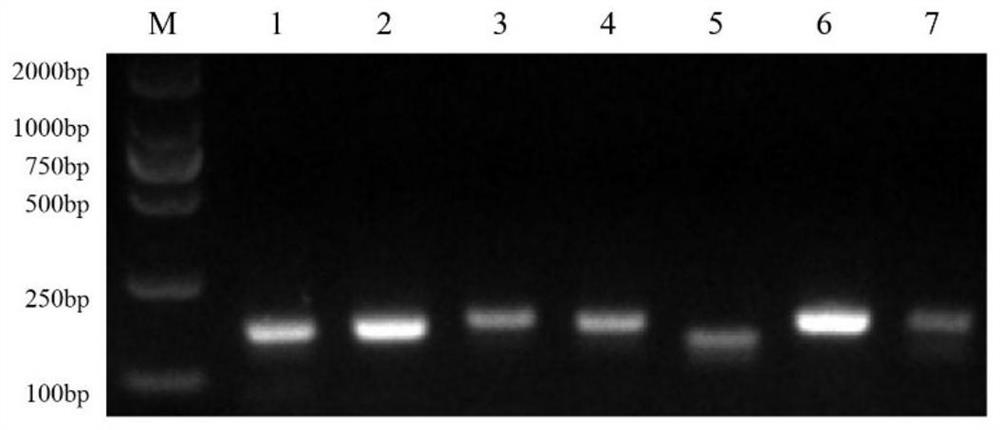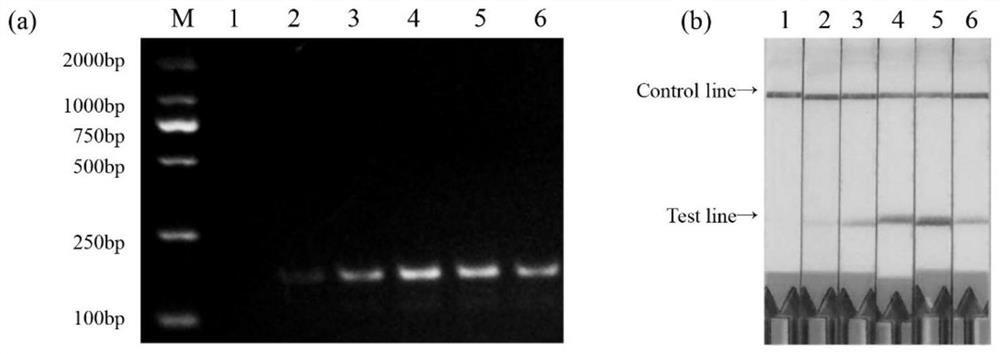A detection kit for the visual detection of D. rottennsis and its application
A potato and stem nematode technology, applied in the field of detection kits for visual detection, can solve the problems of difficulty in widespread use and high price, and achieve the effects of convenient and timely guidance, low equipment cost, and increased stability
- Summary
- Abstract
- Description
- Claims
- Application Information
AI Technical Summary
Problems solved by technology
Method used
Image
Examples
Embodiment 1
[0061] Example 1. Design and screening of primers and probes amplified by recombinase polymerase to identify D. rottennsis
[0062] 1. Design of primers and probes for recombinase polymerase amplification
[0063] D. potato destructor Types A-G, M. incognita, K. elegans, C. beet, C. soy, C. Phillips, C. gramineatum, C. Scribner via NCBI download The gene sequences of nematodes such as nematodes , Caffrea short-body nematodes, pine wood nematodes, D. dwarf nematodes, double-tailed nematodes, oat nematodes and other nematodes were compared to determine the specificity of the ITS2 sequence conserved regions of D. potato rot. Targets D. rot, but not R. incognita, weevil root-knot nematode, beet cyst nematode, soybean cyst nematode, Philip cyst nematode, graminearum, potato golden nematode, Scree The nematodes such as Brachiomorpha bunner, Brachyodon caffeine, B. xylophilus, D. dwarf, and S. oat nematodes can be used for the specific detection of D. rotten nematodes.
[0064] Des...
Embodiment 2
[0113] Embodiment 2. Sensitivity test for identifying D. rottennsis of potato
[0114] Take gDNA from a single nematode and dilute it to 1 / 5, 1 / 5 of the original concentration 2 , 1 / 5 3 , 1 / 5 4 , 1 / 5 5 , 1 / 5 6 , 1 / 5 7 A total of 8 concentrations were used to evaluate the sensitivity of the recombinase polymerase amplification reaction of the present invention.
[0115] use kits and kit for amplification.
[0116] The primers of the kit are the first set of special primers DdNFO-F2 and DdNFO-R2 of the present invention, and the probe is DdITS2-NFO; The primers of the kit are the second group of dedicated primers DdITS2-F2 and DdITS2-R2 of the present invention.
[0117] 1. Extract the DNA of a single nematode to be tested
[0118] The method is the same as in Example 1, and the DNA of D. rottennsis (concentration is 0.1 head / μL) is serially diluted by 5 times, and the DNA of different concentrations after the dilution is used as the template to carry out the recomb...
Embodiment 3
[0127] Example 3. Recombinase polymerase amplification specificity test for identifying D. rottennsis of potato
[0128] The A-C type and other nematodes of different geographical populations of D. rottenta were used as test materials (Table 3) to detect the recombinase polymerase amplification technology of the present invention, agarose gel electrophoresis detection method and lateral flow chromatography test strip detection Specificity after method binding. use kits and kit for amplification. The primers of the kit are the first group of special primers DdNFO-F2 and DdNFO-R2 of the present invention, and the probe is Dd-NFO; The primers of the kit are the second group of dedicated primers DdITS2-F2 and DdITS2-R2 of the present invention.
[0129] 1. Extracting a single DNA of the nematode to be tested: the method is the same as that of Example 1, wherein the nematode to be tested is shown in Table 3.
[0130] Table 3 shows the species or populations of nematodes us...
PUM
 Login to View More
Login to View More Abstract
Description
Claims
Application Information
 Login to View More
Login to View More - R&D
- Intellectual Property
- Life Sciences
- Materials
- Tech Scout
- Unparalleled Data Quality
- Higher Quality Content
- 60% Fewer Hallucinations
Browse by: Latest US Patents, China's latest patents, Technical Efficacy Thesaurus, Application Domain, Technology Topic, Popular Technical Reports.
© 2025 PatSnap. All rights reserved.Legal|Privacy policy|Modern Slavery Act Transparency Statement|Sitemap|About US| Contact US: help@patsnap.com



